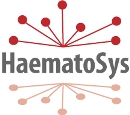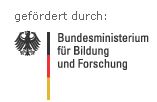HaematoSys
Systembiologie der Hämatopoese und hämatopoetischer Neoplasien
Subproject 2 ¿ Modelling cell kinetics and cell / microenviroment interactions of leukaemic stem cells
Applicants: Ingo Röder (IR), Michael Cross (MC); Andreas Trumpp (AT), Tilo Pompe (TP), Heike Allgayer (HA)
Associated partners (providing methods, data, consultation): C. Eaves, T. Holyoake
Background and own contributions: The progressive clonal dominance characteristic of chronic phase CML results from a competitive advantage of leukaemic stem cells (LSC) over normal stem cells in one or more of the microenvironments in which they reside, defined by the availability of extracellular signals and by the metabolic context in which these signals are seen. The currently unknown CML advantage may result from increased survival or proliferative activity, impaired differentiation and/or the ability to use an extended niche of LSCs. A potential reason for the sustained residual disease observed in most CML patients even under long-term treatment is that TKIs inefficiently affect quiescent (ie. non-proliferating) LSCs. Because there is evidence that quiescent stem cells can be activated into cell cycle, it has been suggested that such an activation strategy is suitable to turn residual LSCs sensitive to TKI treatment. However, the cellular/molecular mechanisms promoting the activation of quiescent stem cells are largely unknown. Our IBM of HSC organisation (cf. WP1/SP1, WP2/SP1) already includes the description of cell cycle activation / silencing of HSCs as well as of stem cell / microenvironmental interactions and, therefore, provides the basis for modelling these processes also in the context of CML.
Objective: It is our objective to provide a detailed model description of the cell kinetics and the related cell-microenvironmental interactions of LSCs and to explain the effect of different manipulation: altered metabolic conditions, cytokine exposure, receptor manipulation. This refined model of LSCs will be incorporated into the disease and treatment model developed in SP1 to investigate individual-cell effects with regard to there systemic implications in the multi-cellular context. It is the ultimate aim to identify new efficient treatment options leading to a complete eradication of (residual) LSCs.
Working program: Based on a series of specifically designed experiments, we will identify regulatory mechanisms that distinguish normal and leukaemic stem cell with respect to cell kinetics and to cell-microenvironmental interactions. Complementary to WP1/SP1 we will now focus on LSC. Once quantified, these mechanisms will be incorporated into the single cell-based disease and treatment model (see SP1) by replacing the current simplified global regulation of proliferative activity and stem cell - stroma interactions explicitly by those mechanisms. In particular, we will disentangle regulatory effects that are governed by stem cell intrinsic mechanisms and those which are induced by the microenvironment. To derive model assumptions, to estimate parameter values, and to validate model predictions, the following classes of experiments will be performed: (i) Cell kinetics and cell – microenvironmental interaction. LSCs will be monitored on a cell population and a single cell level under systematically varied/perturbed (culture) conditions (MC, TP); Cell kinetics will be quantified by long-term labelling studies (AT); see WP1/SP1 for a description of conditions, which are now applied to human LSC from CML patients and to HSCs from two murine models mimicking human CML (transgenic BCR-ABL mouse [2.12]; inducible BCR/ABL FDCPmix model (MC). (ii) Effects of IFN and G-CSF. As already outlined in WP1/SP1, IFN has recently been discovered to activate HSCs into active proliferation, raising the possibility for using IFN to target quiescent LSCs. To be able to find an adequate model description of IFN effects in the mathematical model, we will address the mechanism of IFN-induced activation of quiescent HSCs by analysing a number of downstream effectors which have previously been identified. The model of IFN effects will be tested by comparing model predictions on the combination effect of IFN and TKI-treatment on human CML stem cells obtained from patients. Another potential cytokine for the activation of quiescent (leukaemic) HSCs into cell cycle is G-CSF. To validate our previous model prediction that G-CSF application enhances the therapeutic effect of IM, we will analyse the effects of this cytokine on LSC, by comparing our model results with available in vitro and in vivo data (provided by T. Holyoake). (iii) HSC – stroma interaction. One of the critical model assumptions for the description of CML is an altered cell – stroma interaction of LSC. However, this model assumption is lacking an explicit biological explanation. Because the SDF-1 receptor CXCR4 is described to be an important regulator in the process of HSC–stroma interaction, we will investigate whether CXCR4 regulation is a candidate to describe impaired HSC-stroma interaction in CML. Particularly, we will transplant gene-marked BCR-ABL+ cells into mice and study clonal kinetics, analyze cell migration following treatment with CXCR4 antagonist AMD3100, and examine CXCR4 expression in TKI and AMD3100-treated mice (SF).

